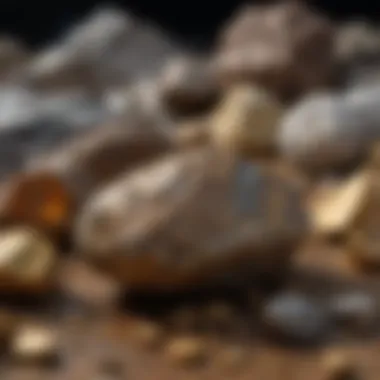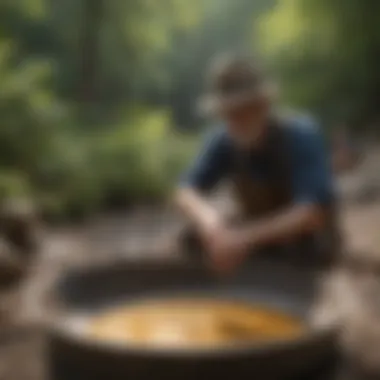Exploring Reed Gold Mine: North Carolina's Historic Treasure


Intro
Nestled within the rolling hills of North Carolina, Reed Gold Mine stands as a testament to a bygone era of discovery and ambition. In the early 19th century, a spark of fortune ignited as the first gold was unearthed in the United States. This mine not only changed the fortunes of many individuals but also significantly influenced the economic landscape of the nation. As visitors make their way to this historical site, they often find themselves on a journey through time, one that weaves together the threads of geology, history, and culture.
From intriguing mining techniques of the past to exploring the geological wonders that lie beneath the surface, Reed Gold Mine offers more than just a glimpse into the world of mining. It's a place where history enthusiasts and rock and fossil collectors converge, eager to unearth both the physical gems and the rich narratives behind them. Whether you're a seasoned collector or just beginning your adventure in this realm, understanding the significance of this mine enhances the overall experience. The following sections will shed light on the mine's invaluable contributions to American history and provide insightful tips for an enriching visit.
Historical Overview of Reed Gold Mine
The Reed Gold Mine stands as a cornerstone in the annals of American history, marking a pivotal point in the gold mining narrative of the United States. This section lays the foundation for understanding the events that propelled this site into historical significance. Redefining the landscape of economic opportunity, the mine not only contributed to the physical wealth of North Carolina but also shaped the cultural and social fabric of the region. Exploring this timeline is essential for grasping how the precious metal altered lives, led to new settlements, and transformed local economies.
The Discovery of Gold
It all began in 1799 when a young boy named Conrad Reed stumbled upon a glittering yellow rock while playing near Little Meadow Creek. This rock, measuring about 17 pounds, turned out to be gold—a discovery that would forever change the lives of many. The Reed family initially dismissed it as just a peculiar stone, using it as a doorstop and later selling it for a mere three dollars.
It wasn’t until a local surveyor recognized its worth that word began to spread. This discovery acted like a match thrown into dry brush, igniting the fervor of gold hunters, entrepreneurs, and dreamers. As word flew across the region, excitement buzzed, and North Carolina's untapped mineral wealth beckoned to many.
The Gold Rush Era
By the mid-19th century, prospectors descended upon North Carolina, transforming the state into a hotbed of mining activity. This Gold Rush era marked a euphoric, albeit chaotic, time in history where individuals and families packed their bags, hoping to strike it rich.
The rush wasn’t just about wealth; it was coupled with a sense of adventure and the pursuit of dreams. Towns sprang up almost overnight—places such as Gold Hill and Charlotte saw rapid growth, fueled by the inrush of miners and their families. The population boomed, fostering the need for services, goods, and infrastructure. It's fascinating to note that North Carolina produced more gold than any state prior to the California Gold Rush, cementing its status as a land of promise and opportunity.
Impact on Local Economy
The implications of the gold discovery extended far beyond just the miners digging in the earth. The economic ripple effects were substantial. Farms thrived as the newfound wealth fueled local commerce; merchants saw a surge in business from miners demanding tools, food, and lodging. The once quiet towns transformed into bustling hubs of commerce.
"Gold brought opportunity, but it also brought challenges that the communities had to navigate."
Investment in infrastructure followed. Roads were constructed, and the establishment of schools and churches became a priority for many new settlements. However, it wasn't just a story of prosperity; local resources were strained, and the environment suffered from the sudden influx of mining activities.
In summary, the historical overview of Reed Gold Mine reveals more than just the spark of gold discovery. It speaks to shifts in economy, profound changes in societal structures, and the dawning of a new era in North Carolina’s narrative. As we delve deeper into each aspect of this remarkable tale, one can see how the threads of history are intricately woven, leading to the rich tapestry that is Reed Gold Mine today.
Geological Significance of Reed Gold Mine
The Reed Gold Mine represents a crucial chapter in the story of mining in the United States. Nestled within North Carolina’s rolling hills, this site is more than just a quaint historical landmark; it embodies the very essence of America’s first gold rush. Understanding its geological significance isn't just about the shiny nuggets of gold. It also reveals insights into the larger geological formations of North Carolina, the historical techniques employed by miners, and the mineral wealth embedded within the earth.
Gold Deposits in North Carolina
North Carolina's geological landscape is rich, brimming with unique formations that offer a treasure trove for rock and fossil collectors. The state is primarily characterized by its ancient crystalline rocks, which date back to the Precambrian era. These formations hold a multitude of mineral deposits, but gold certainly takes center stage.
Interestingly, North Carolina was the site of the first discovery of gold in the United States back in 1799, setting the stage for what would become a significant era in both local and national history. The gold mainly comes from two prime types of deposits - primary or lode deposits and secondary or placer deposits.
- Lode Deposits: These gold deposits are found within quartz veins or alongside other minerals, often requiring substantial effort to extract. They're often characterized by their abundance in mountainous areas, displaying a direct correlation between geological activity and mineral formation.
- Placer Deposits: On the other hand, placer deposits are formed by the weathering and erosion of lode deposits. These lighter gold particles, having been washed away by water, can be found in rivers and creek beds, making them accessible for panning and amateur prospectors.
Each of these types marks significant geological processes. They not only reflect the natural history of the region but also the different approaches taken by miners through the years.
Mining Techniques Used in the Era


The techniques utilized during the era of gold mining at Reed were varied, each possessing its own benefits and challenges in extraction endeavors. Two primary methods defined the gold mining landscape: surface mining and underground mining.
Surface Mining Techniques
Surface mining was all the rage during the early days as it ensured higher yields with lower initial investment. This technique involved removing large amounts of earth to expose mineral seams, making it a practical and efficient choice. One key characteristic is its relatively quick return on investment; miners could sift through the topsoil and gravel in hopes of nudging the elusive flecks of gold to the top of their panning trays.
One unique feature of surface mining is the reliance on water, which was a crucial part of the gold extraction process, helping to separate gold from other materials. While advantageous for its efficiency, this method also had its downsides: significant disturbances to the landscape and the potential for environmental degradation.
Underground Mining Processes
In contrast, underground mining became necessary as surface deposits dwindled. This technique involved digging shafts deep into the earth to reach the more resilient deposits. The pros of this method include less surface disruption and the ability to reach larger and more concentrated deposits of gold.
However, underground mining wasn't without its risks. The environment posed dangers including cave-ins, poor air quality, and the need for intensive labor. Unlike surface mining, which could be seen as a community affair, underground mining often required a dedicated workforce skilled in navigating the murky depths of the earth, highlighting a different facet of mining culture.
Geological formations and Mineralogy
The geological formations surrounding the Reed Gold Mine are complex and tell an age-old story of volcanic and metamorphic activity. The presence of specific minerals, such as quartz and mica, plays an integral role in the mining history. Quartz, for instance, is often associated with gold deposits, serving both as a host rock and a guide to prospectors looking for precious metals. Understanding the mineralogy of this region is crucial for any collector or historian. It underscores the relationship between gold mining practices and the region's geological peculiarities.
The intricate dance of geology and mineral extraction exists at the heart of Reed Gold Mine, where each layer of earth holds tales waiting to be discovered.
This knowledge not only enriches the appreciation of the mine's history but can also enhance the experience for modern visitors and collectors who tread the paths once walked by pioneers in search of fortune.
Cultural Impact of Gold Mining
The significance of gold mining, particularly in the context of Reed Gold Mine, extends beyond mere economic gain. Its cultural impact is woven into the fabric of North Carolinian identity and community. The mining boom not only attracted fortune seekers but also laid the groundwork for settlement and social structures that would persist long after the last gold nugget was extracted. Understanding this element offers valuable insights into how resource extraction reshapes communities, turning them into vibrant hubs filled with unique traditions and histories.
Community Development and Settlement
Gold mining acted as a catalyst for community development in North Carolina. When gold was first discovered in 1799, it set off a flurry of activity. Towns sprang up almost overnight, as hopeful prospectors and families flocked to the area, envisioning a promise of wealth. Places like Charlotte and Gold Hill became bustling centers, not just for mining but for agriculture and trade.
Communities formed around the mine, complete with schools, churches, and trading posts, leading to a vibrant social life. The demand for goods and services led to the rise of local businesses. People forged strong connections, creating a sense of unity that still resonates today.
- Gold mining also led to multicultural exchanges, with people from various backgrounds coming together, bringing their own customs and practices. The interactions fostered a melting pot of ideas and traditions, enriching the local culture.
In short, the impact of the gold rush resulted in long-lasting changes in settlement patterns, economic practices, and community relationships that shaped the region far beyond the mining era.
Legends and Folklore Surrounding the Mine
Legends and folklore surrounding Reed Gold Mine add a layer of intrigue to its history. Tales of hidden treasures and ghostly miners still circulate among locals. One such popular story talks about a lost gold mine deep in the mountain, believed to be cursed, deterring many from seeking it out. Such narratives speak volumes about the human desire for adventure and mystery.
"The stories may not all be true, but they certainly keep the spirit of the gold rush alive."
These legends play a crucial role in the region’s cultural identity. They are often rekindled during annual events, where residents share stories, showcasing how folklore continues to breathe life into community gatherings. The blend of myth and history attracts both visitors and enthusiasts eager to learn ancient tales alongside the scientific aspects of gold mining. The impact of such folklore fosters a sense of pride and connection to the land, reinforcing communal bonds.
Modern Perspectives on Mining Culture
Today, mining culture can appear a tad out of place in a world increasingly concerned with sustainability and environmental issues. Yet, the influence of historic mining on current practices remains significant. There is a growing movement to remember mining not just as an industry, but as a cultural milieu.


- Modern reflections on this culture consider how mining shaped work ethic in the region, influencing entrepreneurial spirit and resilience. This connection is evident in local crafts and art forms that harken back to mining days, where artisans use materials derived from the land to create unique pieces that tell stories.
- Furthermore, educational programs aimed at conservation and sustainable practices borrow from the rich history of mining while emphasizing responsible resource management. They engage communities in discussions about preserving not just the physical landscape but also the storytelling heritage tied to it.
Visiting Reed Gold Mine
Visiting Reed Gold Mine presents a unique opportunity to delve into a crucial part of American history while enjoying an engaging outdoor experience. This site is rich not only in geological wonder but also in stories of human endeavor and community spirit. As you step onto the grounds, you can feel a palpable connection to the past, making it an essential destination for anyone intrigued by history, geology, or simply the thrill of treasure hunting.
One of the key elements to consider during your visit is the visitor facilities and resources available, designed to enhance your experience and provide a deeper understanding of the significance of the mine. Numerous features support both casual visitors and serious collectors alike, ensuring there’s something for everyone.
Tourist Information and Facilities
At Reed Gold Mine, the tourist information center acts as the hub for all visitors. This space not only provides essential maps and brochures but also offers knowledgeable staff to answer queries. The center showcases informative displays about the mine’s history and the broader context of North Carolina’s gold rush.
Facilities include:
- Ample parking space, accommodating visitors throughout the year.
- Restrooms for comfort during your stay.
- A gift shop featuring a selection of gold-related souvenirs and educational materials.
- Picnic areas for those wanting to enjoy their lunch amidst scenic views.
By making use of these resources, visitors can prepare adequately for their exploration, enhancing the overall experience at the mine.
Practical Tips for Collectors
Collecting gold, or even just enjoying the idea of nurturing your inner treasure hunter, relies heavily on timing and safety. Here are some practical pointers for an enriching visit.
Best Times to Visit
The best time to visit Reed Gold Mine is during the spring and fall months. During these times, the weather tends to be milder, and the grounds are particularly picturesque with blooming flora or foliage changes. Notably, spring brings many local events such as gold panning competitions which can be thrilling to witness.
Visiting then also means you may dodge the summer crowds, allowing for a more leisurely exploration of the exhibits and historic themes explored at the site.
Here's what makes this timing beneficial:
- Accessibility: Easier to access exhibits without long lines, enhancing the learning experience.
- Natural Beauty: The scenery provides a perfect backdrop for photos and a chance for reflection on the mining history.
However, visiting in winter could offer a quieter experience, though some facilities might be closed due to weather conditions. Balancing personal preference for busy or relaxed outings will help determine your best time.
Safety Precautions
While visiting Reed Gold Mine is largely safe, adhering to certain safety precautions enriches your experience. The area is mostly free of hazardous conditions, yet it pays to keep a few things in mind.
Key safety points to consider include:
- Follow All Signage: Throughout the mine site, signage provides vital information regarding closed areas or safety messages. Rest assured, being vigilant keeps everyone safe.
- Appropriate Footwear: Wearing sturdy shoes can prevent slips and falls, especially in areas where uneven terrain or water runoff is present.
- Mine Etiquette: Respecting the exhibits and maintaining a safe distance ensures both personal safety and preservation of the site for others to enjoy.
By keeping these tips in the forefront, your visit will be a delightful, safe, and educational experience, leading you deeper into the fascinating world of gold mining history.
Events and Educational Programs
Regular events at the Reed Gold Mine allow visitors to engage not just with the site, but with each other while deepening their knowledge on various topics surrounding gold mining. Workshops, educational programs, and seasonal festivals celebrate mining heritage and promote community involvement. These activities are not just about mining; they cover aspects of local culture, geology, and historical storytelling.


Whether you’re planning a family visit or a solitary adventure, exploring the Reed Gold Mine is bound to be an enlightening journey that resonates long after your visit.
The Legacy of Reed Gold Mine
The Reed Gold Mine stands as a beacon of historical importance, not only in the context of North Carolina's narrative but also in the broader story of American resource exploration. This site represents a cornerstone of gold mining history, embodying the dreams and ambitions of countless individuals during the Gold Rush era. Its legacy is woven into the fabric of local and national identity, making it a vital point of interest for both history buffs and rock collectors alike.
Preservation Efforts and Historical Significance
Preservation of the Reed Gold Mine is a necessary endeavor, safeguarding its history for future generations. The site is managed by the North Carolina Department of Natural and Cultural Resources, emphasizing educational and historical values. Various efforts, such as guided tours, restoration projects, and public outreach programs, have transformed the mine from a mere historical footnote to an interactive learning hub. The historical significance of this mine cannot be understated; it symbolizes the start of commercial gold mining in the U.S., fundamentally altering the economic landscape of North Carolina.
"The Reed Gold Mine reminds us that treasure can often be found not just in the earth, but in our collective past."
The attractions of such efforts are manifold. They provide insight into mining practices, demonstrate the mine's pivotal role in local community development, and contribute to the cultural identity that surrounds North Carolina's gold mining heritage. By engaging visitors in its storied past, these preservation efforts breathe life into what could easily be a forgotten chapter of history.
Influence on North Carolina’s Mining Policies
The Reed Gold Mine's impact extends into the development of mining policies in North Carolina. It highlighted the need for regulations that protect natural resources while allowing for responsible extraction. The initial rush to mine gold led to increased environmental awareness and spurred policy changes aimed at balancing mining interests with conservation efforts. Today, North Carolina's mining laws reflect lessons learned from the past, aimed at fostering sustainable mining practices while promoting economic growth.
These policies also serve to attract businesses interested in exploring the state's rich mineral resources. This journey began with the discovery at Reed and has inspired legislative frameworks that prioritize the responsible management of natural resources. The legacy of the mine continues to inform the discussions surrounding modern mining practices.
The Future of Gold Mining in North Carolina
Looking ahead, the legacy of the Reed Gold Mine invites contemplation of North Carolina's future in gold mining. With advancements in technology and a growing interest in sustainable practices, there’s potential for a new gold rush—one that values environmental integrity alongside economic prosperity. Today’s miners are more informed; they understand the importance of preserving the environment while pursuing their passions for collecting and mining.
The interest in mining extends beyond just gold; it includes a myriad of precious and semi-precious stones, spurring local economies to adapt to changing demands. The potential for educational programs related to mining science and geology could pave new avenues for young enthusiasts, ensuring that the age-old art of mining evolves alongside society.
Research and Resources on Gold Mining
In the quest to understand the rich tapestry that has surrounded Reed Gold Mine, one must pay close attention to the resources available for delving deeper into the world of gold mining. This section serves as a treasure trove of information, from books and articles to online forums and local institutions dedicated to preserving knowledge about this significant part of American history. For enthusiasts and collectors alike, these resources provide vital perspectives not just on the mining activities at Reed, but also on how gold mining has shaped the cultural and economic landscape of North Carolina and beyond.
One of the key benefits of tapping into research and resources lies in their ability to foster a greater appreciation of the sheer effort and technology that underpinned the gold mining era. Understanding the context helps collectors discern the historical significance of their finds, and can even contribute to responsible collecting practices.
Recommended Reading and Bibliography
In terms of recommended reading, several titles might catch your eye:
- "The Gold Seekers of North Carolina: A Concise History" by M.E. Clark. This book offers a comprehensive review from the discovery to the rush, serving as an insightful guide.
- "Mining North Carolina: A History" by James L. McCauley. A detailed insight into various mining practices and their development throughout history.
- "Gold in North Carolina" by William S. Burch III. Ideal for collectors wanting to understand the types of minerals found in the region.
These titles, among others, can give you a better grasp of the historical nuances that inform current mining practices and interests. The bibliographies in these texts often lead to further resources, and it’s worth your time to explore those avenues.
Online Resources and Community Forums
For the digital age enthusiasts, the world of online resources is expansive and invaluable. Websites like Wikipedia and Britannica can provide a foundational understanding of the history of gold mining in the area. There are also community forums, such as those found on Reddit, where collectors and historians share their experiences and knowledge. You can expect riveting discussions on recent finds, mining techniques, and other topics that resonate within the collector community.
Additionally, local social media groups, like those on Facebook, often serve as platforms for interviews with experienced miners or collectors who share tips on where to find artifacts associated with Reed Gold Mine. An active online presence enables a collective effort to preserve history while fostering networking amongst enthusiasts.
Museums and Historical Societies
Lastly, the role of museums and historical societies cannot be understated. Visiting institutions like the North Carolina Museum of History or the Charlotte Museum of History can provide a hands-on experience with artifacts from the era. These places often host exhibitions showcasing the evolution of mining techniques and the tools used at Reed Gold Mine.
Historical societies may also offer guided tours or lectures, providing nuanced insights into the socio-economic impacts of gold mining on communities. Engaging with these resources not only helps enrich your understanding but can also connect you with individuals who share similar interests, fostering a sense of community.
"The best way to learn about history is to immerse yourself in it, to feel its pulse through the stories of those who lived it."



